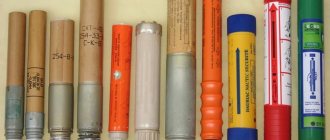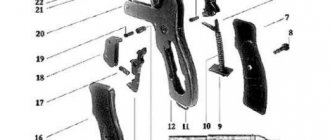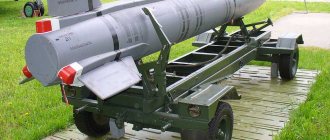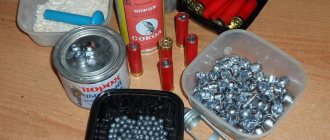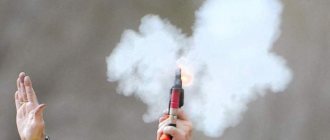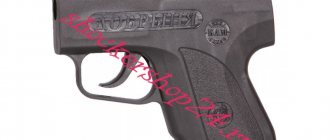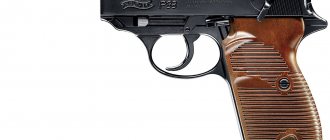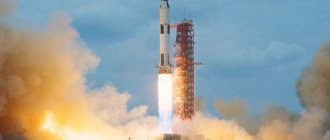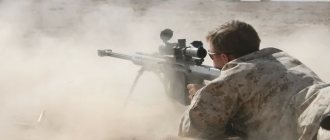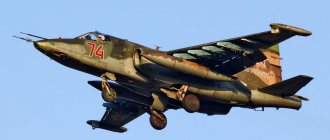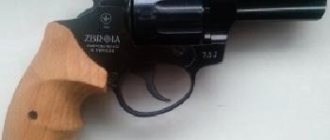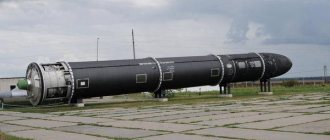A signal flare is a special pyrotechnic means of signaling visual (in some cases, audio) communication, which is used to give warnings, short commands, designate and mutual recognition of their aircraft, ships, troops and transmit transfer signals, call and cease fire and target designation.
Flares are launched from a flare gun, although there is also a one-time device called a “Rocket Launcher.”
Signals
The flare must be as visible as possible, so two effects are used here: either smoke or light. Accordingly, flares are used for lighting and signaling at night, and smoke flares are used during the day. In any conditions, it is recommended to take two types of rockets with you. Poor visibility and wind significantly reduce their effectiveness. The smoke flare is visible for several minutes. Lighting - for a few seconds, but special variations with a parachute are offered. They work for several tens of seconds.
Illumination flares have different glow colors. Moreover, their colors make it possible to encode different information, and with the simultaneous launch of several missiles (usually up to three), the number of signals can be more than ten.
All flares have 2 pyrotechnic charges. One is designed to operate the engine, while the second is designed to receive a smoke or light signal. According to the same scheme, charges are arranged in a signal cartridge for a hunting rifle and in a shot for various artillery.
Here is the meaning of possible signals given by flares of different colors:
• green color – everything is in order, you can continue working;
• red and green – matches, cigarettes and food are required;
• red – help required;
• red, green and red colors - provide a diagram of our location and indicate the exit direction for the aircraft;
• red and red color – dressings and medications are required;
• red, red and red – urgent medical attention is required.
When a signal is sent from several flares, they are carried out at intervals of 8-10 seconds. The interval between individual signals is at least 1 minute.
How to make a beautiful bright rocket out of paper and cardboard with your own hands? Models and diagrams
If preschool children are fascinated and delighted by a small toy rocket, the size of a bottle, then older children will definitely love a “full-length” spacecraft. Such an intergalactic ship will allow children to feel like real captains, and show courage, boldness and courage as the main traits of a man’s character.
Next, you will learn how to make a large model of a rocket out of cardboard and paper with your own hands and see step-by-step photos of this process, which will make the task easier.
Prepare the following materials:
Flare pistol flares
The most famous, accessible and cheapest type of signal flares. They are launched from a compact signal pistol and are popularly called “Rocket Launcher”. The most popular model is the Shpagin signal pistol, which was created in 1943 and is still part of the weaponry today. In addition, several dozen other models are produced on its basis in various countries. Cartridge weight – 50-75 grams, caliber – 26 mm. The expulsion charge is a simple powder charge. The signal has different color options, which we have already listed above. In addition, color coding is used to identify the cartridges themselves.
A shot from a 26 mm signal pistol is not capable of carrying a large flammable charge, so the most effective way to make the signal brighter is a well-known technique in pyrotechnics - the “asterisk”. Such a charge with flammable materials laid so that when burning they scatter in different directions. The army rocket launcher is equipped with red, white, yellow and green cartridges.
Summary
The Crawford bomb we made holds pressure normally, but the junction of the adapter from the gearbox to the high-pressure motor needs to be sealed.
Burning one block increases the pressure in the chamber by 10 bar. This is solved by releasing excess pressure through the relief valve.
The system for monitoring readings and attaching checkers needs to be redesigned. Most likely, we will use an optocoupler and other wires, plus we will make a rod from insulating materials. It's also worth considering reducing the reload time.
Video on the article:
Firmware for electronics
Signal cartridge going to a hunting rifle
Hunters take a signal cartridge with them to indicate their location in case of leaving the route, disaster, or loss of other types of communication. Often, even with high-quality radio communications, it is impossible to indicate your location to other hunters. First of all, this is relevant for a forest in which there are no landmarks. Even in this case, a signal cartridge may be needed. Just in case, it makes sense to take several signal cartridges with you. They can be purchased in hunting stores if you have a hunting license. In addition, they are widely used by the military, since purchase is possible at military stores.
What is important to a hunter is the light weight of the emergency kit, its long shelf life and protection from moisture. Signal cartridges have all these qualities. They use military developments and modern reliable technological solutions. In addition to shotgun cartridges, a separate device with a firing mechanism (it can also be called a “hunter’s signal”) and a separate device with a large-caliber barrel are offered.
Color additives for light and smoke signals
Only green, red and white (white-yellow, colorless) missiles are widely used by the military. The following color additives are well developed and optimized for them:
- red home signal and red flame color – strontium nitrate;
- green color of smoke and flame - barium nitrate;
- deep and blue color – copper chloride;
- yellow – sodium, as well as its compounds;
- white smoke and flame color - various gunpowders, aluminum.
We have given general designations for signals. You can use any other schemes, but only after prior agreement. All other colors (orange, carmine, purple) are obtained by mixing metal salts. In addition, organic dyes have long been used. For example, a signal orange house is obtained by simply adding a dye of the appropriate color.
White flares are usually called flares. Their pyrotechnic composition is designed for maximum high light output and a bright white flame with combustion. There is an objective and simple method of calculation: the ratio of light intensity in CD per each weight unit of the composition is measured.
The principle of launching a signal flare
Preparation of rocket cartridges for firing is carried out under the supervision of army commanders. Launching a flare is easy. The launch principle is as follows: take the flare into the left rocket so that you can wrap your fingers around the metal base in the launch tube - in this case, the palm should in no case protrude further than its lower edge. The flare, firmly grasped in the hand, is held at chest level. In this case, the signal cartridge should be pointed upward and slightly forward of the person launching the rocket.
Using the right hand, the cap is screwed off the trigger tube, while the position of the device remains unchanged. Once the cap is screwed on, carefully pull the lanyard, as well as the metal ring, out of the launch tube. But try to avoid sudden jerks. Signal flares are launched on command directly from the hands.
To launch a flare from your hand, you need to do the following: with your right hand, grab the end of the lanyard, limited by the ring. The rocket will then require the required direction and angle of its launch, after which the lanyard will be pulled out with a jerk. Following the rocket's departure, a launch tube with a lanyard is thrown.
Most often, machine guns are used as a stop. The absence of stops significantly increases the dispersion of missiles, which requires a large number of cartridges to illuminate targets.
Short range pyrotechnic lighting
Along with other ammunition, the Russian Armed Forces supply a large number of short-range pyrotechnic lighting and signaling equipment, which includes lighting, signaling and imitation equipment used within the range of close-range weapons.
Pyrotechnic devices (PTS) are products equipped with pyrotechnic compositions intended to produce light, smoke, heat, dynamic or other special effects.
Pyrotechnic compositions (PS) include mechanical mixtures of finely divided or liquid flammable substances, oxidizers, binders and special additives. The predominant type of transformation of pyrotechnic compositions under conditions of official use is combustion. By their nature, many pyrotechnic compositions are explosive substances and, under certain conditions, are capable of detonating, but their explosive properties are much less pronounced than those of conventional explosives. High-calorie metals (magnesium, aluminum), hydrocarbons (gasoline, kerosene, fuel oil, etc.) and carbohydrates (sawdust, starch, etc.) are used as fuels. Compounds that can release oxygen relatively easily are used as oxidizing agents - nitrates, chlorates, perchlorates and metal oxides. Natural (rosin, shellac) and artificial (bakelite, iditol) resins are used as binding additives to impart mechanical strength to the compositions. Special additives color the flame (smoke), enhance the effect and phlegmatize the compositions.
In accordance with their purpose and nature of action, pyrotechnic means are divided into:
- short-range: lighting, signaling and simulation;
- fire action: tracers, ignition, incendiary;
- dynamic action: squibs and pyroautomatics;
- countering infrared and radar guidance systems (creating false targets);
- decorative lights: fireworks and salutes;
- other special effects (light and sound, etc.).
Lighting means
Lighting equipment (OS) is designed to illuminate the area at night for the purpose of observation, orientation and fire destruction of enemy targets. According to methods of use, lighting products are divided into three groups:
- short-range - pistol and rocket illumination cartridges;
- artillery - illuminating mines and shells;
- aviation - flare bombs, missiles and landing gear.
To achieve the greatest lighting effect, lighting pyrotechnic compositions must:
- have a high combustion temperature - from 500 °C and above;
- have a spectrum of emitted light that is closest to that of the sun;
- form solid or liquid products during combustion, since the temperature glow of gases and vapors is insignificant.
These conditions are best met by pyrotechnic compositions in which the fuels are magnesium or aluminum (30% magnesium or 28% aluminum), which have a high combustion temperature, and the oxidizing agents are barium and sodium nitrates (66–68% barium nitrate), potassium and sodium perchlorates with luminescent additives for brightness.
Signaling means
Signaling devices (SS) are designed to provide color light signals for the purpose of interaction, warning, orientation and identification.
According to methods of use, signaling devices are divided into three groups:
- short-range - mortar, pistol and rocket cartridges;
- aviation - signal cartridges and special starting devices;
- ships - distress signals, flares, etc.
According to the conditions of use, signaling devices are divided into:
- night - forming colored lights when the signal composition burns;
- daytime - forming colored smoke, visible at certain distances;
- combined - combining several effects (sound and light, etc.)
Signaling means can be air and ground, single- and multi-star, single- and multi-color, parachute and non-parachute. The most common is a 3-color signaling system (red, green and yellow lights). Less commonly used is a 4-color alarm system, supplemented with white and a 5-color alarm system with white and blue lights. Ground signals use blue and orange smoke.
To achieve a bright signaling effect, the combustion of pyrotechnic compositions must be luminescent, since combustion products in the form of gases or vapors give the sharpest color color to the flame. As a rule, to produce a red flame, strontium salts are used as fuel, green - barium salts, yellow - sodium salts. The compositions have a characteristic color and a low burning rate - a few millimeters per second. The most common signal compounds are:
- red light: strontium carbonate - 25%; Berthollet salt - 60%; iditol (resin) - 15%;
- green fire: barium nitrate - 25%; barium chlorate - 63%; iditol - 12%;
- yellow light: sodium oxalate - 25%; Berthollet salt - 60%; IDitol - 15%.
The main developer and manufacturer of all lighting and signal cartridges in the Russian Federation is the Federal Research and Production Plant in Sergiev Posad, Moscow Region.
Lighting sockets
26-, 30-, 40- and 50-mm reactive illumination cartridges are designed to illuminate the area and targets at night immediately in front of friendly combat formations
troops. Illumination with reactive illumination cartridges is carried out to orient personnel on the ground, to monitor enemy actions, as well as in the interests of solving fire missions by rifle units, direct infantry support tanks and escort artillery.
The 26-mm single-star illumination cartridge (OP) is designed to illuminate the area when firing from 26-mm signal pistols: mod. 1928; Shpagina arr. 1943 (SPSh); arr. 1944 (SPSh-44); SP-81.
The 26 mm cartridge consists of:
- folder sleeve with a metal base;
- lighting star with retarder-igniter;
- KVM-3 igniter capsule;
- expelling charge of black powder;
- felt wad, lower and upper cardboard wads;
- cardboard tube and a distinctive circle with raised marks.
The bottom part of the sleeve base has a protruding flange and a capsule socket. The expelling charge in the cartridge case is covered by a cardboard wad with a gauze circle. The lower wad keeps the charge from moving along the sleeve and ensures uniform pressure of the gases formed during the shot on the sprocket. The felt wad protects the sprocket from destruction when fired - softens the blow. Both wads have a central hole to transmit the beam of fire to the igniter of the lighting star.
The cardboard tube and upper wads serve to secure all parts in the sleeve. The distinctive circle is attached by rolling the edge of the cartridge case inward and has convex identification marks and coloring according to the purpose of the cartridge. The lighting star consists of a pyrotechnic composition. When a pistol is fired, the impact of the firing pin on the primer ignites the primer composition, and a beam of fire ignites the expelling charge. The resulting powder gases emit a lighting star, which, thanks to the moderator, ignites at a height of 35–40 m. The bright combustion of the star illuminates the area within a radius of up to 150 m.
The length of the OP cartridge case is 75 mm (the length of the old-style OP cartridge case is 100 mm), the cartridge caliber is 26.6 mm.
The metal base of the 26-mm lighting cartridge sleeve is marked with the number or symbol of the factory and the year of manufacture of the cartridge. In addition to markings, the 26 mm lighting cartridge has special colored and raised identification marks to determine their purpose during the day and at night.
To recognize the 26mm illumination cartridge during the day, the upper surface of the distinctive circle of the cartridge is painted white to match the color of the fire.
To identify the 26 mm illumination cartridge at night by touch, three round bumps arranged in a triangle are stamped on the distinctive circle of the cartridge.
30-mm and 40-mm reactive illumination cartridges have been supplied to troops since 1950 and are ready-made shots that do not require special weapons or additional devices for shooting.
30-mm and 40-mm old-style reactive illumination cartridges differ from 30-mm and 40-mm extended-range reactive illumination cartridges by modified tactical and technical characteristics. They have no differences in the principle of design and operation and methods of use.
The 50 mm reactive illumination cartridge is used along with 30 mm and 40 mm reactive illumination cartridges, depending on the combat missions solved by the unit. The 50-mm cartridge provides the ability to conduct aimed fire at night from tanks and artillery pieces at a range of up to 1500 m, and from small arms - at all valid ranges. This cartridge has a special remote device that allows you to change the illumination range in accordance with the combat situation.
The 30-mm extended-range reactive illumination cartridge ROUP (index 57-SN-625 U) is designed to illuminate terrain and targets at a distance of up to 500 m in front of the battle formations of friendly units. The ROUP cartridge has been produced since the early 1960s and consists of:
- starting cardboard tube with a metal base;
- flares with lighting star;
- a pressure tube with two cardboard wads;
- ignition device;
- lids and caps with identification marks.
The rocket consists of a rocket part, an expelling charge and a lighting star and is a cylindrical container made of aluminum with a diameter of 26.5 mm, which houses: a lighting star in a special shell with an igniter and an expelling charge made of black gunpowder; a plastic turbine with one central and three lateral inclined holes (nozzles) designed for the exit of powder gases from the reactive part and a reactive charge of nitroglycerin powder, which is the source of rocket movement.
The ignition device is a pull-out, grating type, has an igniter capsule in the form of a metal cup with wide edges, filled with a friction-sensitive composition, with a wire grater rolled into a spiral. A lanyard with a ring is attached to the lower end of the grater.
Releasing the lanyard and firing a 30mm reactive illumination cartridge from the hand from a standing position
To use the reactive cartridge, first twist the cap from the launch tube and remove the lanyard with the ring. Then, holding the jet cartridge by the base, point it upward and sharply pull the cord by the ring. When the cord with the float is pulled out, the friction-sensitive composition ignites, and a beam of fire is transmitted through the central hole of the turbine to the reactive charge. The resulting powder gases eject the rocket from the launch tube, and it flies in a given direction. Since the side nozzles of the turbine are located at an angle to the axis of the rocket, it also acquires rotational motion, which is necessary to give it stability in flight. The pressure tube, wads and cover fall to the ground near the rocket launch site. The launch tube remains in the shooter's hand. Simultaneously with the reactive charge, the burning of the ignition star in the cardboard shell begins, which after 3–4 s ends with the activation of the expelling charge and the separation of the burning star from the reactive part. When missiles are launched at an angle of 40–50°, the illumination star ignites at a distance of about 250 m from the firing point and at an altitude of approximately 150 m. During the first one to two seconds after separation, the illumination star flies forward and upward, reaching a height of 200–250 m at a distance of 300–350 m, then begins to decline; stops burning at an altitude of 30–50 m and at a distance of 400–500 m from the shooting site. When changing the height and moving away the lighting star, the intensity and radius of the illumination change.
The burning time of the lighting star is 8–10 seconds. The length of the cartridge is 230 mm, the length of the base is 54 mm (previously 94 mm), diameter is 32.0 mm. Weight - 0.2 kg. The maximum visibility range of manpower is 500 m, tanks, armored personnel carriers/infantry fighting vehicles are 600 m. The radius of area illumination is up to 240 m.
30-mm high-precision reactive lighting cartridge (index 7 C20)
The 30-mm high-precision reactive lighting cartridge (index 7 C20), unlike the ROUP cartridge, has a shortened plastic launch tube without a metal base and a plastic cap. The cartridge length is 155 mm, diameter is 32.0 mm. In addition, in the military, 30-mm extended-range reactive illumination cartridges may be encountered with a percussion ignition mechanism instead of a grating mechanism. The procedure for firing such cartridges is set out in the special instructions contained in each box of cartridges.
The 40-mm extended-range reactive illumination cartridge ROUP (index 7 C3) is designed to illuminate terrain and targets in front of combat formations of units at a distance of up to 800 m. The 40-mm reactive illumination cartridge, in addition to a general device similar to the 30-mm ROUP cartridge, has the following additional devices:
- powder ignition amplifier above the igniter primer;
- a special pyrotechnic retarder in a metal cup to transmit a beam of fire from the igniter star to the expelling charge;
- a parachute placed at the top of the rocket, thanks to which the fall of the star is slowed down.
The rocket consists of an aluminum body, which houses the rocket part, the expelling charge and the lighting star with a parachute. The aluminum cover and felt wad prevent the rocket from moving in the launch tube and also protect the cartridge from moisture.
The action of the 40mm cartridge is similar to that of the 30mm rocket illumination cartridge. The ignition of the expelling charge and the illuminating star of a 40-mm cartridge occurs 5–7 s after the shot at a distance of approximately 500 m from the shooting site and at an altitude of 150–200 m (when shooting at an angle of 30–35°). A burning illumination star with a parachute, under the influence of an expelling charge, pushes out the head cap and flies out of the rocket body. The parachute opens, the star slowly (at a speed of 4–5 m/s) descends on the parachute, illuminating the area. The burning of the star ends at a height of 50–75 m from the ground.
Depending on the height of the burning star, the range and radius of illumination of the area changes. When the lighting star burns out at an altitude of 150–200 m, it descends by parachute at a speed of 4–5 m/s, illuminating targets at a distance of 550–600 m. The illumination radius is 200–250 m. When the star descends to a height of 50–75 m, the illumination radius increases to 320 m, and the target visibility range increases to 650–800 m.
The burning time of the lighting star is 22–25 seconds. The length of the cartridge is 210 mm, the length of the base is 114 mm, the diameter is 41.0 mm. Weight - 0.39 kg. The maximum visibility range of manpower is 800 m, tanks, armored personnel carriers/infantry fighting vehicles are 1000 m. The radius of area illumination is up to 320 m.
The 40-mm modernized reactive lighting cartridge (index 7 S3 M), unlike the 40-mm ROUP cartridge, has a plastic launch tube without a base and a plastic cap. The cartridge length is 187 mm, diameter is 41.0 mm.
30-mm and 40-mm reactive illumination cartridges of outdated models differ from modern extended-range ROUP cartridges by shorter composite metal bases of the launch tube and a smaller reactive charge.
The launch tubes of 30 mm reactive illumination cartridges are marked with the number or symbol of the plant, the batch number of the cartridges, the year of manufacture and the name of the cartridge.
The markings of the 40 mm reactive illumination cartridge are also marked on the launch tube. It contains the number or symbol of the plant, batch number and year of manufacture of the cartridge.
In addition to markings, 30 and 40 mm reactive lighting cartridges have special colored and raised identification marks to determine their purpose during the day and night.
To recognize 30 mm rocket cartridges in the daytime, the lower surface of the cartridge cap is painted in a color corresponding to the color of fire or smoke (lighting cartridges are white).
Old style 30mm reactive illumination cartridges also have cartridge caps painted white.
To identify 30 mm jet cartridges at night, raised identification marks are stamped on the cartridge caps by touch.
The cap of the ROUP extended-range lighting cartridge has one oblong rectangular bulge.
The old-style single-star lighting socket on the cap has three round bulges arranged in a triangle, and the two-star socket has one oblong rectangular bulge.
To recognize a 40-mm illumination cartridge (both extended range and the old model), a convex identification mark is stamped on the cover - a parachute dome; the lid is painted white.
Shooting 30-mm and 40-mm reactive illumination cartridges can be done from various positions: standing, kneeling, lying down.
It is recommended to shoot signal cartridges at an angle of 70–80°, and for lighting cartridges: 30 mm – at an angle of 40–50°, 40 mm – at an angle of 30–35°.
In severe frosts, as well as when burning stars fall to the ground, the firing angle of the cartridges should be increased.
Lighting cartridges can be fired without a stop, however, this significantly increases the dispersion of missiles and more cartridges will be required to illuminate the target.
The 50-mm long-range reactive illumination cartridge ROPD (index 7 S9) is designed to illuminate terrain and targets, support the firing of artillery and tanks up to 500 m, and small arms at all target ranges.
The 50-mm reactive illumination cartridge is designed similarly to the 40-mm ROUP reactive illumination cartridge, but unlike the latter, it has a special remote device designed to regulate the missile’s flight range, mounted between the rocket’s reactive part and the illuminating star. The remote mechanism consists of the following parts:
- a disk body with open annular and radial channels, which are filled with a slow-burning pyrotechnic composition;
- a transfer ring with a cylinder of pyrotechnic composition;
- installation ring with a side cutout for the cuff tooth;
- movable cuff with tooth.
The cuff is fixed in the transverse cutout of the wall of the metal base of the launch tube. The extreme positions of the cuff correspond to the settings of 800 and 1200 m. The transfer and installation rings are put on the central protrusion of the threaded body and secured with a nut.
The remote device works as follows: when the cuff is turned, its tooth rotates the installation ring and the associated transfer ring, as a result of which the length of the part of the annular channel with the pyrotechnic composition from the radial channel to the cylinder changes, and, consequently, the time of slowing down its combustion and the flight range of the rocket.
When fired, a beam of fire after the combustion of the igniter star ignites the retarding composition of the remote device, and then the cylinder of the pyrotechnic composition and the expelling charge. The expulsion charge ignites the illumination star and throws it out of the rocket body by parachute.
The action of the 50mm cartridge is similar to that of the 30mm and 40mm reactive illumination cartridges.
When the cartridge is installed at a distance of 800 m, the lighting star ignites 7–9 s after the shot at a distance of approximately 800 m from the shooting site and at an altitude of 200–250 m (when shooting at an angle of 30–35°).
When installing the cartridge at a distance of 1200 m, the illuminating star lights up 13–15 s after the shot at a distance of 1200 m from the shooting site and at an altitude of approximately 200–250 m (when shooting at an angle of 40–45°).
A burning illumination star descends by parachute, illuminating the area and targets located on it. The lighting star ends at a height of 100 m from the ground.
To illuminate targets located at a distance of 600–1000 m from the shooting site, the cartridges are fired when the remote device is installed at a distance of 800 m. To illuminate targets located at a distance of 1000–1500 m from the shooting site, shooting is carried out when the remote device is installed at a distance 1200 m.
It is prohibited to shoot 50-mm rocket cartridges directly from the hands (without a rest), since when firing, due to high recoil, the position of the hands may change, which will lead to a sharp deviation of the rocket from the direction of fire. When shooting, you should take into account the direction of the wind, since a burning star with a parachute will be blown away.
Shooting a 50-mm ROPD remote-action reactive illumination cartridge from the knee using an assault rifle.
You can shoot 50-mm illumination cartridges using a rest from various positions (standing, kneeling, lying down).
To prepare a 50-mm illumination cartridge for shooting, it is taken in the left hand so that the fingers tightly clasp the metal base of the launch tube, and the palm does not protrude beyond its lower edge. The cartridge, held tightly in the hand, must be held at chest level, with the top of the cartridge always facing up and forward from the shooter. After that, the required missile flight range is established in the daytime and at night using convex identification marks on the base of the launch tube and on the cuff. In addition, on the trigger tube there is the number 800 against the right convex sign, the number 1200 against the two left signs, and above the numbers there is an arrow indicating the direction of rotation of the cuff when changing the setting to the range from 800 to 1200 m.
The burning time of the lighting star of a 50-mm ROPD remote-action reactive lighting cartridge is 25–30 seconds. The cartridge length is 290 mm, diameter is 53.0 mm. Weight - 0.85 kg. The maximum visibility range of tanks, armored personnel carriers/infantry fighting vehicles is 1500 m. The radius of area illumination is 250–300 m.
On the top of the launch tube of the 50 mm ROPD lighting cartridge there is a marking indicating the number or symbol of the plant, the batch number and the year of manufacture of the cartridge.
For identification purposes, a parachute canopy is depicted on the cover of the 50 mm illumination cartridge.
Sergey Monetchikov Photo from the author’s archive
Precautions when firing flares
In severe frosts and when luminous stars fall to the ground, the firing angle of the cartridges increases significantly. It is advisable to ensure that the hand, pulling the cord, moves along the axis of the pressed cartridge simultaneously with the machine gun. Otherwise, when jerking, the cartridge in the upper part may become dislodged, as a result of which the rocket will simply stray from its intended course.
If you are shooting 40 mm cartridges, you need to take into account the direction of the wind. His presence will blow the parachute with the hot star aside. As a result, in the presence of a side wind, the direction of the shot is set, taking into account the direction of the wind. In strong headwinds, the use of lighting sockets is not recommended.
Obviously, you should not use flares close to buildings or towards people. In addition, when starting, it is important to take care of your own safety.
One of the main disadvantages of signal lighting in combat conditions is that the shooter declassifies his location, as a result of which he becomes accessible to the enemy. Therefore, the use of lighting cartridges in emergency situations should be carried out only when absolutely necessary.
Classification according to conditions and methods of use
Light warning devices, depending on the conditions of use, are:
- At night - when they burn, colored lights are formed.
- During the day - during the combustion process, colored smoke is released. It is visible at a distance determined by the characteristics of the pyrotechnic product.
- Combined - combine sound and light effects.
- Air, ground, surface - depending on the location of application (on land, on water, in the air).
